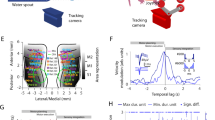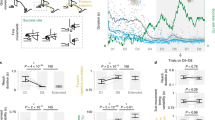Abstract
Understanding how the brain constructs movements remains a fundamental challenge in neuroscience. The brain may control complex movements through flexible combination of motor primitives1, where each primitive is an element of computation in the sensorimotor map that transforms desired limb trajectories into motor commands. Theoretical studies have shown that a system's ability to learn action depends on the shape of its primitives2. Using a time-series analysis of error patterns, here we show that humans learn the dynamics of reaching movements through a flexible combination of primitives that have gaussian-like tuning functions encoding hand velocity. The wide tuning of the inferred primitives predicts limitations on the brain's ability to represent viscous dynamics. We find close agreement between the predicted limitations and the subjects’ adaptation to new force fields. The mathematical properties of the derived primitives resemble the tuning curves of Purkinje cells in the cerebellum. The activity of these cells may encode primitives that underlie the learning of dynamics.
This is a preview of subscription content, access via your institution
Access options
Subscribe to this journal
Receive 51 print issues and online access
$199.00 per year
only $3.90 per issue
Buy this article
- Purchase on Springer Link
- Instant access to full article PDF
Prices may be subject to local taxes which are calculated during checkout




Similar content being viewed by others
References
Mussa-Ivaldi, F. A., Giszter, S. F. & Bizzi, E. Linear combinations of primitives in vertebrate motor control. Proc. Natl Acad. Sci. USA 91, 7534 –7538 (1994).
Schaal, S. & Atkeson, C. G. Constructive incremental learning from only local information. Neural Comput. 10, 2047–1084 (1998).
Shadmehr, R. & Mussa-Ivaldi, F. A. Adaptive representation of dynamics during learning of a motor task. J. Neurosci. 14, 3208–3224 (1994).
Ghez, C., Krakauer, J. W., Sainburg, R. L. & Ghilardi, M. F. in The New Cognitive Neurosciences (ed. Gazzaniga, M. S.) 501–514 (MIT Press, Cambridge, Massachusetts, 2000).
Thoroughman, K. A. & Shadmehr, R. Electromyographic correlates of learning internal models of reaching movements. J. Neurosci. 19, 8573–8588 (1999).
Gandolfo, F., Mussa-Ivaldi, F. A. & Bizzi, E. Motor learning by field approximation. Proc. Natl Acad. Sci. USA 93, 3843–3846 (1996).
Conditt, M. A., Gandolfo, F. & Mussa-Ivaldi, F. A. The motor system does not learn the dynamics of the arm by rote memorization of past experience. J. Neurophysiol. 78, 554–560 (1997).
Goodbody, S. J. & Wolpert, D. M. Temporal and amplitude generalization in motor learning. J. Neurophysiol. 79, 1825–1838 (1998).
Conditt, M. A. & Mussa-Ivaldi, F. A. Central representation of time during motor learning. Proc. Natl Acad. Sci. USA 96, 11625–11630 (1996).
Kawato, M. Adaptation and learning in control of voluntary movement by the central nervous system. Adv. Robotics 3, 229– 249 (1989).
Sanner, R. M. & Kosha, M. A mathematical model of the adaptive control of human arm motions. Biol. Cybern. 80, 369–382 (1999).
Bhushan, N. & Shadmehr, R. Computational architecture of human adaptive control during learning of reaching movements in force fields. Biol. Cybern. 81, 39–60 (1999).
Shadmehr, R. & Brashers-Krug, T. Functional stages in the formation of human long-term motor memory. J. Neurosci. 17, 409–419 (1997).
Georgopoulos, A. P., Schwartz, A. B. & Kettner, R. E. Neural population coding of movement direction. Science 233, 1416–1419 ( 1986).
Moran, D. W. & Schwartz, A. B. Motor cortical representation of speed and direction during reaching. J. Neurophys. 82, 2676–2692 (1999).
Conrad, B., Matsunami, K., Meyer-Lohmann, J., Wiesendanger, M. & Brooks, V. B. Cortical load compensation during voluntary elbow movements. Brain Res. 71, 507–514 (1974).
Goodkin, H. P., Keating, J. G., Martin, T. A. & Thach, W. T. Preserved simple and impaired compound movement after infarction in the territory of the superior cerebellar artery. Can. J. Neurol. Sci. 20, S93–S104 (1993).
Bastian, A. J., Martin, T. A., Keating, J. G. & Thach, W. T. Cerebellar ataxia: abnormal control of interaction torques across multiple joints. J. Neurophysiol. 76, 492– 509 (1996).
Lang, C. E. & Bastian, A. J. Cerebellar subjects show impaired adaptation of anticipatory EMG during catching. J. Neurophysiol. 82, 2108–2119 ( 1999).
Nezafat, R., Shadmehr, R. & Holcomb, H. H. Neural correlates of motor memory retention over a 4 week period as quantified through PET. Soc. Neurosci. Abs. 25, 2178 (1999).
Imamizu, H. et al. Human cerebellar activity reflecting an acquired internal model of a new tool. Nature 403, 192– 195 (2000).
Coltz, J. D., Johnson, M. T. V. & Ebner, T. J. Cerebellar Purkinje cell simple spike discharge encodes movement velocity in primates during visuomotor arm tracking. J. Neurosci. 19, 1782–1803 (1999).
Matsouka, Y. Models of generalization in motor control. PhD thesis, MIT ( 1998).
Amirikian, B. & Georgopulos, A. P. Directional tuning profiles of motor cortical cells. Neurosci. Res. 36, 73–79 (2000).
Houk, J. C. & Wise, S. P. Distributed modular architectures linking basal ganglia, cerebellum, and cerebral cortex: their role in planning and controlling action. Cereb. Cortex 5, 95–110 (1995).
Wolpert, D. M. & Kawato, M. Multiple paired forward and inverse models for motor control. Neural Networks 11, 1317–1329 (1998).
Spoelstra, J., Schweighofer, N. & Arbib, M. A. Cerebellar learning of accurate predictive control for faster-reaching movements. Biol. Cybern. 82, 321–333 (2000)
Gandolfo, F., Li, C. S. R., Benda, B. J., Schioppa, C. P. & Bizzi, E. Cortical correlates of learning in monkeys adapting to a new dynamical environment. Proc. Natl Acad. Sci. USA 97, 2259–2263 ( 2000).
Holdefer, R. N., Miller, L. E. & Houk, J. C. Functional connectivity between cerebellum and primary motor cortex in the awake monkey. J. Neurophysiol. 84, 585–590 (2000).
Martin, J. H., Cooper, S. E., Hacking, A. & Ghez, C. Differential effects of deep cerebellar nuclei inactivation on reaching and adaptive control. J. Neurophysiol. 84, 1886– 1899 (2000).
Acknowledgements
We thank M. A. Smith, O. Donchin, and R. Nezafat. The work was supported by grants from the Office of Naval Research and the National Institutes of Health (to R.S.), and a research traineeship from the National Science Foundation (K.A.T.).
Author information
Authors and Affiliations
Corresponding author
Rights and permissions
About this article
Cite this article
Thoroughman, K., Shadmehr, R. Learning of action through adaptive combination of motor primitives. Nature 407, 742–747 (2000). https://doi.org/10.1038/35037588
Received:
Accepted:
Issue Date:
DOI: https://doi.org/10.1038/35037588
This article is cited by
-
Prediction error in implicit adaptation during visually- and memory-guided reaching tasks
Scientific Reports (2024)
-
Reinforcement learning establishes a minimal metacognitive process to monitor and control motor learning performance
Nature Communications (2023)
-
Divisively normalized neuronal processing of uncertain visual feedback for visuomotor learning
Communications Biology (2023)
-
A theoretical perspective on action consequences in action imagery: internal prediction as an essential mechanism to detect errors
Psychological Research (2023)
-
Contribution of implicit memory to adaptation of movement extent during reaching against unpredictable spring-like loads: insensitivity to intentional suppression of kinematic performance
Experimental Brain Research (2023)
Comments
By submitting a comment you agree to abide by our Terms and Community Guidelines. If you find something abusive or that does not comply with our terms or guidelines please flag it as inappropriate.



